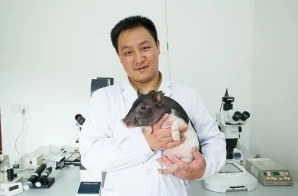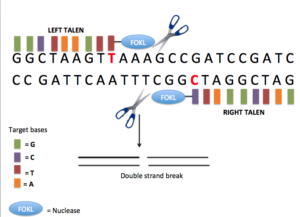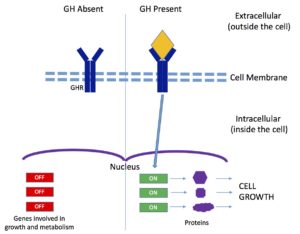21 Optional Section – Micropigs
Micropigs are tiny, genetically-edited pigs that have recently been developed by a Chinese genomics institute (Li, 2014) (Image 1).

The Chinese scientists used a technique called TALENs to edit the genome of pig cells (Figure 1). Each cell inside a pig contains two copies of the growth hormone receptor gene: one from each of its parents. The TALENs technique was used to delete one of the two copies of this gene.

Growth hormone (GH) stimulates the growth of essentially all tissues within the body. GH is a 191 amino acid peptide (protein) hormone which is produced from the GH gene. Cells sense the presence of GH protein hormone with the growth hormone receptor (GHR) protein on the outside of the cell. GHR protein is produced from the GHR gene and is found on the cell membrane on the outside of cells.
The GHR protein has three major parts:
- An extracellular region that sticks out from the outside surface of the cell
- A transmembrane region that goes through the cell membrane and anchors the receptor to the membrane
- An intracellular region on the inside of the cell membrane that transmits signals to the interior of the cell.
The extracellular region binds (attaches) to GH, fitting together like a lock and its key. The binding of growth hormone transmits signals through the cell membrane to the intracellular region of the receptor (Figure 2). These signals “turn on” genes involved in growth and metabolism so that those genes are made into proteins. These proteins stimulate the growth and division of other cells in the organism.
If growth hormone is not present, the organism will not grow to full size. In humans, severe GH deficiency can lead to an adult height of only 4 feet tall. If growth hormone receptor is not present, the “grow” signal from the GH will not be transmitted inside of cells, so growth will not be stimulated.

References
Li f, Li Y, Liu H, Zhang H, Liu C, Zhang X, Dou H, Yang W, Du Y. 2014 Sep. Production of GHR double-allelic knockout Bama pig by TALENs and handmade cloning. Yi Chuan: 36(9):903-11.
Image 1: Springer Nature allows adaptation of figures for style and formatting purposes under CC-BY under the condition that this does not alter the meaning of the content. The rights in the material are owned by a third party. This image is available from: Cyranoski, D. 2015. Gene-edited ‘micropigs’ to be sold as pets at Chinese institute. Springer Nature. https://www.nature.com/articles/nature.2015.18448


Feedback/Errata